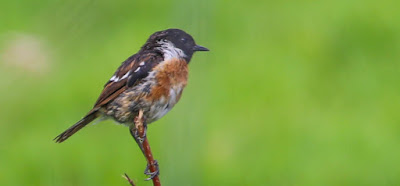We visited Portugal in late June and early July of 2022. On Saturday, June 25, we had a day of birding in the Tagus Estuary with Bernardo Barreto of
Birds & Nature.
The Tagus River (Tejo in Portuguese) is the longest river in the Iberian Peninsula. It arises in mid-eastern Spain and flows 626 miles (445 in Spain, 29 along the shared border of Spain and Portugal, and 171 in Portugal) where it empties into the Atlantic Ocean with the Tagus Estuary as its mouth. The Tagus Estuary covers 84,000 acres (131 square miles) and is the largest estuary in western Europe. The water in the estuary has a maximum depth of 33 feet. The
Tagus Estuary Natural Reserve was established in 1976 and covers 35,070 acres. Most of it is in the upstream (northern) area of the estuary, but with a small portion in the vicinity (both north and south) of the eastern end of the Vasco de Gama Bridge.
 |
| The Tagus Estuary, The red line shows our very approximate route, going counter-clockwise. This map does not show the smaller roads closer to the estuary that we were often using. |
Bernard picked us up at our hotel in Lisbon at 7:30 a.m.. We spent a few minutes in Lisbon watching swifts swarming above us, then drove southeast over the Tagus (Estuary) on the 10.7 mile long
Vasco da Gama Bridge, the second longest bridge in Europe.
 |
| Pallid Swift |
 |
| Vasco de Gama Bridge and Lisbon |
I didn't have a map with me and so I did not have much concept of where we were most of the time. Our first and longest stop was at a private farm not too far past the bridge. I'm not sure if the farm was in the Natural Reserve, but I believe it was just beyond it. Birds & Nature has an arrangement with the farm that gives them access to a wonderful area, including pools of water and cork oak woodland. This was by far the most productive area for seeing birds. We saw nesting black-winged stilts, nesting Kentish plovers, a nesting booted eagle, common shelducks, lots of greater flamingos (another favorite), a black kite, Iberian magpies, yellow-crowned bishops, mallards and little grebes.
 |
| Black-winged stilt |
 |
| Kentish plovers |
 |
| Booted eagle |
 |
| Common shelduck |
 |
| Greater flamingo |
 |
| Greater flamingo with glossy ibis's |
 |
| Black kite |
 |
| Iberian magpie |
 |
| Yellow-crowned bishop |
 |
| Mallard |
 |
| Black-crowned night heron |
 |
| Eurasian collared dove |
 |
| Gull-billed tern |
 |
| Little bittern |
 |
| Little tern |
 |
| Western yellow wagtail |
Not too far away we stopped near a shopping center and saw one of my favorite birds of the day, a European hoopoe. It is the last place I would have expected to see one.
 |
| European hoopoe |
We drove through a beautiful area of cork woodland and did not see many birds, after all it was mid-day, but we did see a number of European bee-eaters, another of my favorites of the day.
We ate sandwiches in a restaurant in a small town that I do not recall and nearby stopped at what used to be salt pans, an area where they made salt. I saw, but was not able to photograph, a beautiful European greenfinch and was able to get a poor photograph of a European serin.
We saw some other birds that I have a hard time placing.
 |
| Barn swallow with a white belly, different than those found in the U.S. |
 |
| Red-rumped swallow |
 |
| Immature black-winged stilt |
 |
| Carrion crow |
 |
| Cattle egret |
 |
| Common swallow |
 |
| Eurasian spoonbill |
 |
| European stonechat |
 |
| Greater flamingo |
Just a short distance before crossing a bridge across the Tagus (above the estuary) at Vila Franca de Xira, we drove through extensive fields, including rice and wheat or some
other grain. We saw several purple herons, grey herons, gulls, white
storks and a Eurasian kestrel.
 |
| Grey heron |
 |
| Purple heron |
 |
| White stork |
 |
| Eurasian kestrel |
 |
| Little egret |
Then we crossed the bridge over the Tagus and returned to Lisbon along the eastern side of the Tagus and the estuary.
Overall, I counted 38 species of bird I'd d seen, with 20 of them ones I'd never seen before. The only birds I included on my list that I was not able to photograph were crested mynas, a Eurasian jay, a European greenfinch, a great cormorant, some little grebes and a European honey buzzard, all birds I remembered well. At the end of the day Bernard provided a list of the estuary birds and checked the boxes of birds we'd seen. There were birds he saw that I didn't, or didn't remember, as I was concentrating on taking photos and missed some of them, particularly ones that were a great distance away or very hard to see. Among birds on the list that I didn't count were a great egret, western marsh harrier, common moorhen, ruddy turnstone, black-headed gull, rock dove, common wood pigeon, crested lark, common blackbird, Cetti's warbler, winter wren, European blue tit and spotless starling.

















































That's an impressive number of birds for one area on one day. It was a fun day of bird watching, and it was truly exciting to get such great views of flamingos.
ReplyDelete